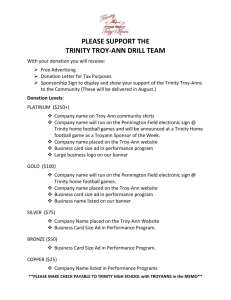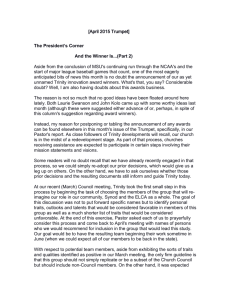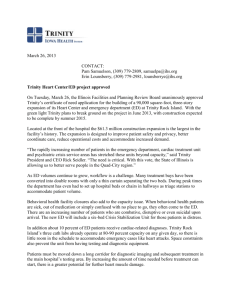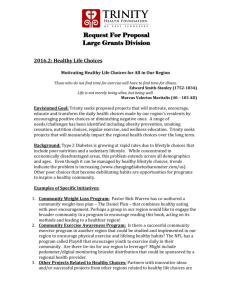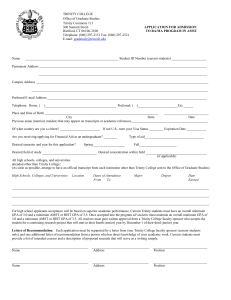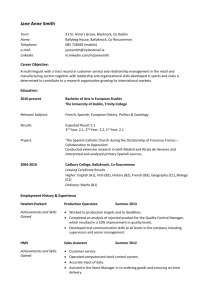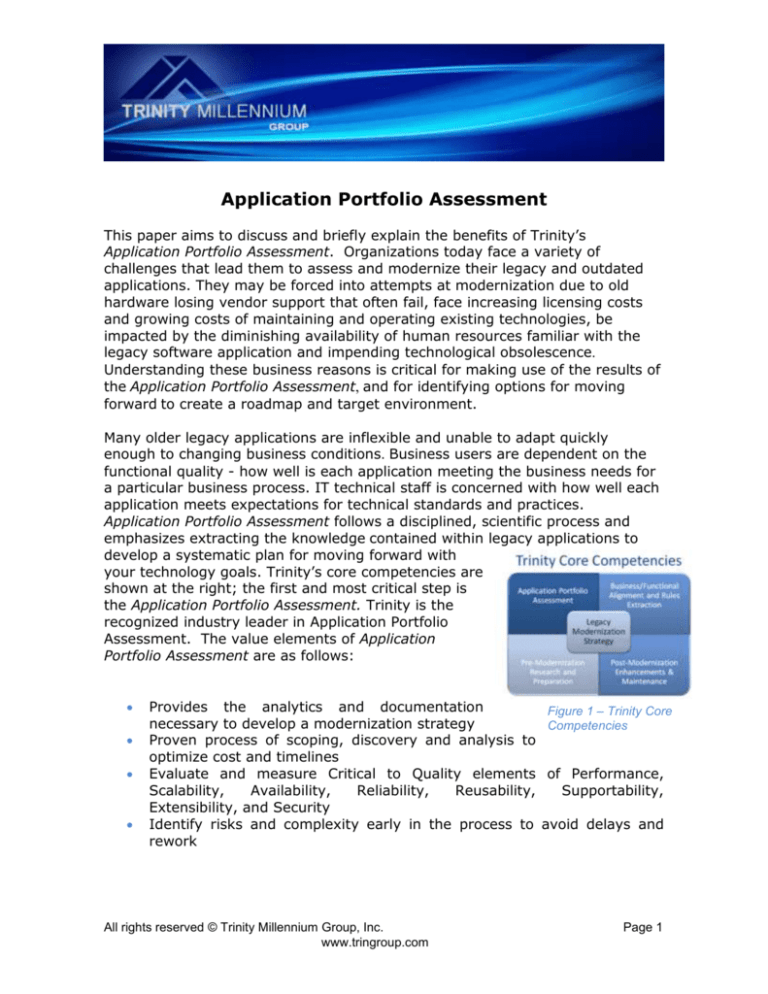
Application Portfolio Assessment
This paper aims to discuss and briefly explain the benefits of Trinity’s
Application Portfolio Assessment. Organizations today face a variety of
challenges that lead them to assess and modernize their legacy and outdated
applications. They may be forced into attempts at modernization due to old
hardware losing vendor support that often fail, face increasing licensing costs
and growing costs of maintaining and operating existing technologies, be
impacted by the diminishing availability of human resources familiar with the
legacy software application and impending technological obsolescence.
Understanding these business reasons is critical for making use of the results of
the Application Portfolio Assessment, and for identifying options for moving
forward to create a roadmap and target environment.
Many older legacy applications are inflexible and unable to adapt quickly
enough to changing business conditions. Business users are dependent on the
functional quality - how well is each application meeting the business needs for
a particular business process. IT technical staff is concerned with how well each
application meets expectations for technical standards and practices.
Application Portfolio Assessment follows a disciplined, scientific process and
emphasizes extracting the knowledge contained within legacy applications to
develop a systematic plan for moving forward with
your technology goals. Trinity’s core competencies are
shown at the right; the first and most critical step is
the Application Portfolio Assessment. Trinity is the
recognized industry leader in Application Portfolio
Assessment. The value elements of Application
Portfolio Assessment are as follows:
Provides the analytics and documentation
necessary to develop a modernization strategy
Proven process of scoping, discovery and analysis to
optimize cost and timelines
Evaluate and measure Critical to Quality elements
Scalability,
Availability,
Reliability,
Reusability,
Extensibility, and Security
Identify risks and complexity early in the process to
rework
All rights reserved © Trinity Millennium Group, Inc.
www.tringroup.com
Figure 1 – Trinity Core
Competencies
of Performance,
Supportability,
avoid delays and
Page 1
iSAT™
Core deliverables generated from the Application Portfolio Assessment are
delivered as the Interactive Software Analysis Tool (iSAT™). Fundamentally,
the iSAT™ is an HTML webpage with links to libraries of key artifacts and
various elements of information and/or images. The iSAT™ can be viewed with
any regular web browser.
Figure 2 – Interactive Software Analysis Tool
Application Analytics
Trinity’s Application Analytics is a powerful solution that delivers a
comprehensive inventory of all applications in your IT portfolio. It provides a
mutual understanding of size, technical make-up, and complexity of the
applications - and reveals the breadth, depth and scope of modernization
requirements.
Application Scoping captures the volume of the base source code exactly as it
was received from the client. Frequently, the client has a much larger code base
than what they were aware of. The iSAT Delta Report is a detailed document
showing changes in the code base, down to the character level, between two
selected codebase versions (for example, codebases provided on different
All rights reserved © Trinity Millennium Group, Inc.
www.tringroup.com
Page 2
dates). Depending on the goals of the client, Delta Reports can be used to
enable clients to make any required modifications to a production codebase in
order to avoid code freezes during Trinity analysis. Delta Reports are also
helpful to legacy developers in identifying either intended or unintended
changes present in the source code since the last code drop delivered to Trinity.
Application Analytics determines the general character and culture of the
application(s). The primary goals are to understand the size, complexity, and
quality of the software application, with a view toward determining how best to
move forward with this application. With this information possible risks are
identified early in the process to avoid delays and rework when planning for a
transformation or migration to COTS. Understanding the complexity of the code
has a great impact whether there is a migration or not; key elements are
measured in the Analytics phase with the goal of improving the ratings in the
following Critical to Quality Dimensions:
Scalability – The ability to support a certain number of simultaneous
users and a growing database while continuing to meet performance
expectations
Availability – Operational accessibility of an application. No production
system crashes/outages. Minimal downtime for maintenance
Reliability – Integrity and consistency of application data and
transactions. No lost or duplicated transactions
Reusability – Code is completely or partially reusable in another system
Supportability – Ease of repairing defects (average time to repair)
Extensibility – Ease of providing new functionality or expanding existing
functionality
Performance – Average response time for a typical screen transaction or
online report
Security – Detection and prevention of unauthorized access (accidental or
deliberate to programs or data. Change management tractability
Application Analytics delivers several useful and meaningful artifacts. Some
examples are the following:
Verb Frequency Report - this is generated from ASTs originating from the
source code and reflects how often a verb is used in the legacy source
code. This information is pertinent, especially when there are external
calls, links, transfer control, invokes and other verbs that join one
module to another – showing that dependency. Also, the number of
conditionals, such as If, When, Evaluate, Case, etc., indicate how many
candidate rules exist in the code. These candidate rules can be processed
to extract business rules, technical rules, data access objects, etc.
All rights reserved © Trinity Millennium Group, Inc.
www.tringroup.com
Page 3
Complexity - The effort required to understand, evaluate and navigate a
legacy application depends on more than just the size of the application
(that is, more than just the number of lines of source code). The effort is
also dependent on how complex and convoluted the code is. Trinity uses
industry-standard methods to measure complexity of computer
programs, including the Halstead complexity metric. Trinity looks for
operators, operands, decision points, decision depth, # of unit test
injection, and the level of effort to transform.
Business Characterization - A printable document, the Business
Characterization Report describes in detail the scope of the client source
code base and provides an analysis of these categories: Overview of
Applications, Business Drivers, Application Size, Program Statistics
(number of internal calls, external calls, loops, go-to’s, classes, etc.),
Organization of the code, Interfaces that exist within the application(s),
Organization of databases, Complexity, Documentation levels, Databases
and Tables, and Recommendations. The discovery of the interfaces and
their description and architecture is a valuable part of this report.
Business Alignment - The Business Alignment report identifies the entry
points (online or batch) for Business Requirements, Business Functions
and Business Activities. When these are identified, programs and jobs
that are no longer in use can be removed from the repository to save
costs. Trinity collaborates with the client to identify the Business
Requirements (BRs) of the firm, those essential enterprise functions that
the application must support. The Business Functions (BFs) and the
Business Activities (BAs) of those requirements are captured and
documented. A Business Alignment Document or BADOC is developed,
depicting supporting code elements in outline form including “Entry
Points” for each Business Function or Activity.
The Topology process
analyzes the IT Application and can be used to align code elements with
the functional organizational departments that they support.
The artifacts in Application Analytics provide the support needed to identify
risks, prevent delays, reduce costs and define the roadmap for the client’s
business needs.
Application Forensics
All rights reserved © Trinity Millennium Group, Inc.
www.tringroup.com
Page 4
Application Forensics identifies and extracts all essential or critical knowledge
from the applications that support your business. It is important for the client to
truly understand the culture and nature of the application legacy source code.
The primary objective is to extract and capture critical knowledge contained
within the source codebase in order to fully understand the source code, its
core logic and to conduct detailed analysis. Application Forensics also reveals:
Knowledge and Understanding of the complex business rules activities
being performed by the legacy application code
Legacy coding practices that restrict maintenance or enhancement.
Development environment constraints that require specialized,
expensive, and/or hard to find skill sets or licenses.
Database access performance, flexibility, and cleanliness.
Identification of various types of functionality - within the legacy software
and the context of this approach, known as aspects. To identify all of the
code within a program related to a given aspect, one must typically
locate code based on several patterns. Each aspect normally has several
associated slices, so an aspect can be regarded as a collection of slices.
For example, error handling is one aspect. Several types of “slices” are
necessary for identifying all of the various portions of code related to
error handling in a given program.
Application Forensics delivers the following artifacts, among others to assess
the current state of the legacy application:
Data Dictionary
File Comparison Report
Block Comparison Report
CRUD Report
Dead Code/JCL Report
Application Overview Map (AOM)
Flowcharts
Business Rules Catalog (optional)
The Application Forensics solution provides your business and technical staff
valuable insight into application design flow and the use of business rules,
All rights reserved © Trinity Millennium Group, Inc.
www.tringroup.com
Page 5
without interrupting focus on production support and ongoing development
requirements.
Conclusion
The Application Portfolio Assessment provides a rapid, cost-effective, low-risk
way to leverage the tremendous investment your legacy IT assets represent
and report on those results.
Document Contributors
Laurie K. Wells (Author & Concept Graphics). Director, Analysis & Delivery,
Trinity Millennium Group Inc.
All rights reserved © Trinity Millennium Group, Inc.
www.tringroup.com
Page 6

